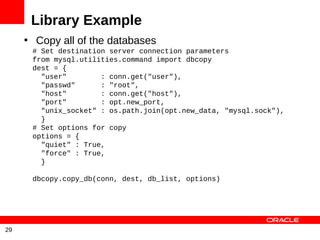Python Utilities for Managing MySQL Databases
- 1. <Insert Picture Here> Python Utilities for Managing MySQL Databases Mats Kindahl, Lars Thalmann, Chuck Bell
- 2. THE FOLLOWING IS INTENDED TO OUTLINE OUR GENERAL PRODUCT DIRECTION. IT IS INTENDED FOR INFORMATION PURPOSES ONLY, AND MAY NOT BE INCORPORATED INTO ANY CONTRACT. IT IS NOT A COMMITMENT TO DELIVER ANY MATERIAL, CODE, OR FUNCTIONALITY, AND SHOULD NOT BE RELIED UPON IN MAKING PURCHASING DECISION. THE DEVELOPMENT, RELEASE, AND TIMING OF ANY FEATURES OR FUNCTIONALITY DESCRIBED FOR ORACLE'S PRODUCTS REMAINS AT THE SOLE DISCRETION OF ORACLE. 2
- 3. About the Speakers • Mats Kindahl, PhD • Replication Expert and Lead Developer • [email protected] • Lars Thalmann, PhD • Development Director, Replication, and Backup • [email protected] • Chuck Bell, PhD (not present) • MySQL Utilities and Replication • [email protected] 3
- 4. Topics • Introduction to MySQL Utilities • List of current utilities • Architecture of MySQL Utilities • Examples of usage • Using the MySQL Utilities Python Library 4
- 5. What is MySQL Utilities? • A collection of Python utilities for managing MySQL databases • Part of MySQL Workbench 5.2.31 • Available under the GPLv2 license • Written in Python • Easily enhanced using a growing code library • Goal is to provide a Python library to grow solutions for common administrative problems 5
- 6. List of Utilities • mysqldbcompare – compare databases • mysqldbcopy – copy databases between servers • mysqldbexport – export metadata and data • mysqldbimport – import metadata and data • mysqldiff – compare object definitions • mysqldiskusage – show disk usage for databases • mysqlindexcheck – check for redundant indexes • mysqlmetagrep – search metadata • mysqlprocgrep – search process information • mysqlreplicate – setup replication • mysqlrplcheck – check replication configuration 6
- 7. List of Utilities • mysqlserverclone – start a scratch server • mysqlserverinfo – show server information • mysqluc – console for utilities • mysqluserclone – clone a user account 7
- 8. Utilities in MySQL Workbench • Launch the MySQL Utilities command window: – Click on the Plugins menu item – Select “Start Shell for MySQL Utilities” OR • From the Workbench main window: – Click on the drop down arrow icon to the right of the main window – Scroll through screens to find the MySQL Utilities icon 8
- 9. How do I access the utilities? 9
- 10. How do I access the utilities? 10
- 11. Structure of the MySQL Utilities mysqlprocgrep Scripts Command Common Module Module mysql.utilities.command mysql.utilities.common MySQL Utilities Library 11
- 12. mysqldbcompare – compare databases • Find missing objects from either database • Find objects that differ in definition • Find differences in data among tables • Print difference in formats differ, ndiff, or context • Print output rows in GRID, TAB, CSV, or VERTICAL formats • Scenarios • checking master and slave for consistency • checking production and development databases for consistency • generating a difference report for expected differences among new and old data • comparing backups for differences 12
- 13. Sample execution $ mysqldbcompare --server1=root@localhost --server2=root@backup_host:3310 > inventory:inventory --run-all-tests # server1 on localhost: ... connected. # server2 on localhost: ... connected. # Checking databases inventory on server1 and inventory on server2 WARNING: Objects in server1:inventory but not in server2:inventory: VIEW: finishing_up VIEW: cleaning Defn Row Data Type Object Name Diff Count Check --------------------------------------------------------------------------- TABLE supplier pass FAIL FAIL Row counts are not the same among inventory.supplier and inventory.supplier. Data differences found among rows: --- inventory.supplier +++ inventory.supplier @@ -1,2 +1,2 @@ code,name -2,Never Enough Inc. <user>:<password>@<host>:<port>:<socket> +2,Wesayso Corporation 13
- 14. mysqlmetagrep – search objects • Search for objects with names matching a pattern • Match using SQL patterns or POSIX regular expressions • Search bodies of routines (procedures, events, triggers) • Generate SQL for executing the query – Can be used in applications – Can be stored in events or views _” 14
- 15. Searching for objects by name Searching a database for objects starting with “t” mysqlmetagrep pattern="t_" server=mats@localhost $ mysqlmetagrep pattern="t_" server=mats@localhost +++++++ | Connection | Object Type | Object Name | Database | Field Type | Matches | +++++++ | mats:*@localhost:3307 | TABLE | t1 | test | COLUMN | th | | mats:*@localhost:3307 | TABLE | t1 | test | TABLE | t1 | | mats:*@localhost:3307 | TABLE | t2 | test | TABLE | t2 | | mats:*@localhost:3307 | TABLE | tt5 | test | COLUMN | t2,t1 | +++++++ 15
- 16. Searching routine bodies Searching a database for objects containing “l_host” mysqlmetagrep body pattern="%l_host%" server=mats@localhost $ mysqlmetagrep body pattern="%l_host%" server root@localhost:3307 +++++++ | Connection | Object Type | Object Name | Database | Field Type | Matches | +++++++ | root:*@localhost:3307 | PROCEDURE | switch_master | test | ROUTINE | switch_master | +++++++ 16
- 17. mysqlprocgrep – search processes • Search processes on multiple machines • Match by PROCESSLIST fields – Id, State, User, Host, Database, Command, State, Info • Match by age – Find long-running queries, or idle connections • Get SQL for performing the query or action – Put in application – Put in events • Kill queries or connections – Option: killquery – Option: killconnection 17
- 18. Sample usage • Find queries by 'www-data' that have been executing for more than 20 minutes mysqlprocgrep [email protected] matchuser=wwwdata matchstate=executing age=20m ++++++++++ | Connection | Id | User | Host | Db | Command | Time | State | Info | ++++++++++ | mats:*@example.com:3306 | 53 | mats | example.com | user | Query | 2040 | executing | select … | ++++++++++ 18
- 19. Sample usage • Find queries by 'www-data' that have been executing for more than 20 minutes mysqlprocgrep [email protected] m! matchuser=wwwdata matchstate=executing The age=20m killquery i ll K 19
- 20. mysqlreplicate – setup replication • Permits an administrator to start replication among two servers. • User have to provide: – Login information to the slave – Connection information for the master • Example: Setup replication between two instances mysqlreplicate --rpl-user=rpl_user:xyzzy --master=root@localhost:3306 --slave=root@localhost:3307 20
- 21. mysqluc – MySQL Utilities Console • User defined variables • Help features • Tab completion (names, parameters, options, variables) 21
- 22. MySQL Utilities Python Library • Major classes for: • Database • Replication • Server • Index • Table • User • Also many helpful methods such as • connect_servers() • setup_common_options() • format_tabular_list() • find_running_servers() 22
- 23. Library Example • Goal: create a utility that makes a copy of a running server and copies all of the data and users. • Steps • Setup the parameters • Connect to the original server • Find all of the databases • Find all of the users • Make a clone of the original server • Copy all of the databases • Copy all of the users 23
- 24. Utility options • Server to read from: server • Databases: databases • Data directory for new server: newdata • Port for new server: newport • Server ID for new server: newid 24
- 25. Set up options from optparse import OptionParser parser = OptionParser() parser.add_option("server", action="store”, dest="server", type="string", default="root@localhost:3306", help="connection information for original server in " "the form: <user>:<password>@<host>:<port>:<socket>") parser.add_option("d", "databases", action="store", dest="dbs_to_copy”, type="string", help="commaseparated list of databases " "to include in the copy (omit for all " " databases)”, default=None) . . . 25
- 26. Library Example • Parse the connection information from mysql.utilities.common.options import parse_connection try: conn = parse_connection(opt.server) except: parser.error("Server connection values invalid or" " cannot be parsed.") • Connect to original server from mysql.utilities.common.server import Server server_options = {'conn_info’ : conn, 'role’ : "source"} srv1 = Server(server_options) srv1.connect() 26
- 27. Library Example • Find all of the databases db_list = [ (db[0],None) for db in srv1.get_all_databases() ] • Find all of the users _QUERY = """ SELECT user, host FROM mysql.user WHERE user != 'root’ AND user != '' """ users = srv1.exec_query(_QUERY) user_list = [ user[0] + '@' + user[1] for user in users ] 27
- 28. Library Example • Make a clone of the original server from mysql.utilities.command.serverclone import clone_server res = clone_server(conn, opt.new_data, opt.new_port, opt.new_id, "root", None, False, True) 28
- 29. Library Example • Copy all of the databases # Set destination server connection parameters from mysql.utilities.command import dbcopy dest = { "user" : conn.get("user"), "passwd" : "root", "host" : conn.get("host"), "port" : opt.new_port, "unix_socket" : os.path.join(opt.new_data, "mysql.sock"), } # Set options for copy options = { "quiet" : True, "force" : True, } dbcopy.copy_db(conn, dest, db_list, options) 29
- 30. Library Example • Copy all of the users from mysql.utilities.command.userclone import clone_user options = { "overwrite" : True, "quiet" : True, "globals" : True } for user in user_list: res = clone_user(conn, dest_values, user, (user,), options) 30
- 31. Enhancing the example • Consistent copy? – Locking tables – Consistent snapshot (InnoDB) • Copying all users? – Users not related to the database? – Users with only global privileges? • Automatically start replication • Killing connections? 31
- 32. Where To Go From Here You can download MySQL Workbench from: http://www.mysql.com/downloads/workbench/ You can also download the latest development source code tree for the MySQL Workbench Utilities from: http://launchpad/net/mysqlutilities 32
- 33. MySQL High Availability Get it as free ebook: http://oreilly.com/go/ebookrequest Valid this week, mention event “MySQL Replication Update” MySQL Support: www.mysql.com/contact PHP under the hood Thu 10:40am MySQL Technology Update Thu 2:30pm MySQL Binlog API Fri 10:00am Visit MySQL at Oracle booth 701! 33
- 34. 34

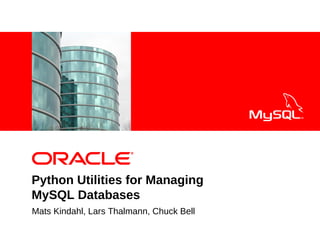
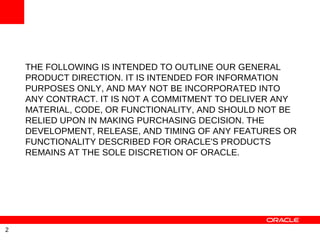

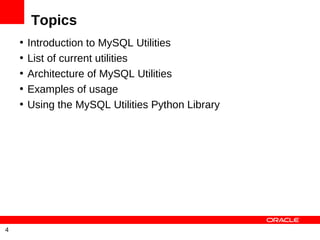




















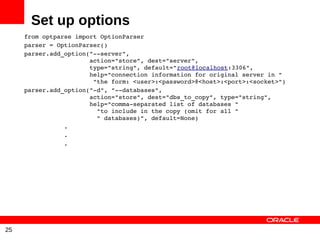

![Library Example
• Find all of the databases
db_list = [ (db[0],None) for db in srv1.get_all_databases() ]
• Find all of the users
_QUERY = """
SELECT user, host FROM mysql.user
WHERE user != 'root’ AND user != ''
"""
users = srv1.exec_query(_QUERY)
user_list = [ user[0] + '@' + user[1] for user in users ]
27](https://image.slidesharecdn.com/pythonutilitiesformanagingmysqldatabases-110728103859-phpapp01/85/Python-Utilities-for-Managing-MySQL-Databases-27-320.jpg)

